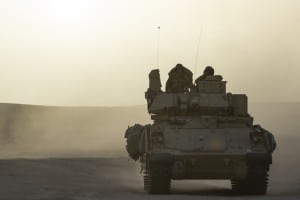General Dynamics [GD] this week detailed its offering for the Army’s Optionally Manned Fighting Vehicle, the only proposal submission accepted for the competition’s prototype phase, which company officials told Defense Daily
was built from the ground up for the program.
Keith Barclay, GD Land Systems’ director of global strategy and growth, said the decision to offer a purpose-built platform, after previously considering an option based on its Griffin III technology demonstrator, was borne out of the extensive discussion with the Army as officials worked through the requirements process.

“We’ve been listening to the Army. The Army’s been clear and consistent about its requirements for about two years. They’ve had unprecedented engagements with us and all the industry partners. Based upon that, the combination of all those things, lead us to the conclusion that it had to be a purpose-built platform to get the maximum amount of capability and to manage all the requirements,” Barclay told Defense Daily at the Association of the United States Army conference (AUSA) in Washington.
Barclay said GD couldn’t go into specifics of components on the company’s offering, but he said the new platform was designed around five key components for the Army’s OMFV outlook.
The vehicle includes a 50mm gun, an objective requirement for OMFV, an integrated active protection system, capacity for third-generation FLIR sensors.
The platform’s chassis is also new for the program, rather than offering Griffin III’s design based on the Ajax model, and built to meet the requirement to fit two OMFV’s on a C-17.
Barclay specifically highlighted the vehicle’s electronic architecture system designed to roll-in future technologies as the Army grows the platform.
“We really think that our catalyst next-generation electronic architecture is the backbone, if you will, of the vehicle. From power to displays to the way the whole crew station is held out and the ability to integrate new capabilities, that’s what’s critical,” Barclay said.
The approach to purpose-build a new platform rather than going with Griffin III, which the company showed at last year’s AUSA conference, was attributed to the iterative discussion on requirements with the Army, according to Barclay.
“If you’re focused on the capabilities that the Army clearly wanted, and with the maximum amount of objective capability, then this the approach that you would have to follow, in our opinion,” Barclay said.
GD is effectively the only competitor left in the OMFV prototype competition after the Army disqualified Raytheon [RTN] and Rheinmetall’s Lynx fighting vehicle offering after the two companies were unable to deliver a bid sample by the Oct. 1 deadline.
Rheinmetall told Defense Daily this week the company is looking to keep discussing options with the Army on participating in the Optionally Manned Fighting Vehicle competition (Defense Daily, Oct. 14).
The Army’s plan is to award up to two OMFV prototype contracts next year for vendors to deliver 14 test vehicles. Barclay said GD has not discussed any adjustments to the program following Lynx’s disqualification.
“The Army has not come to us at all. We’ve had our head down and we turned in our bid sample and proposal, and it’s being evaluated by the Army,” Barclay said.